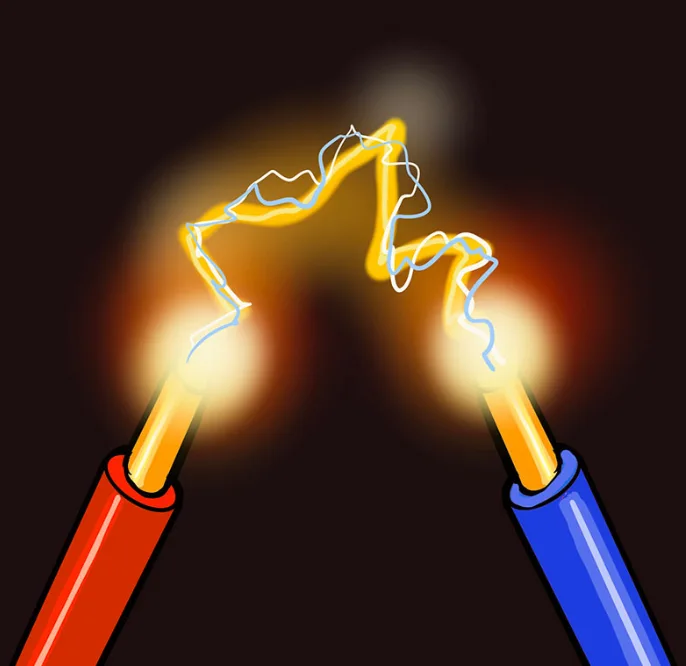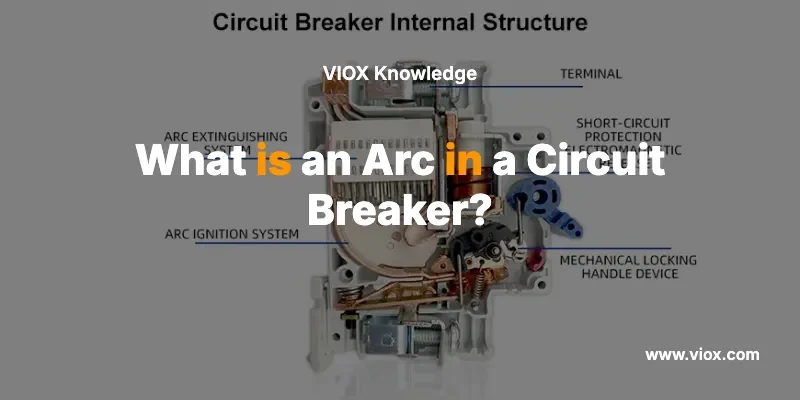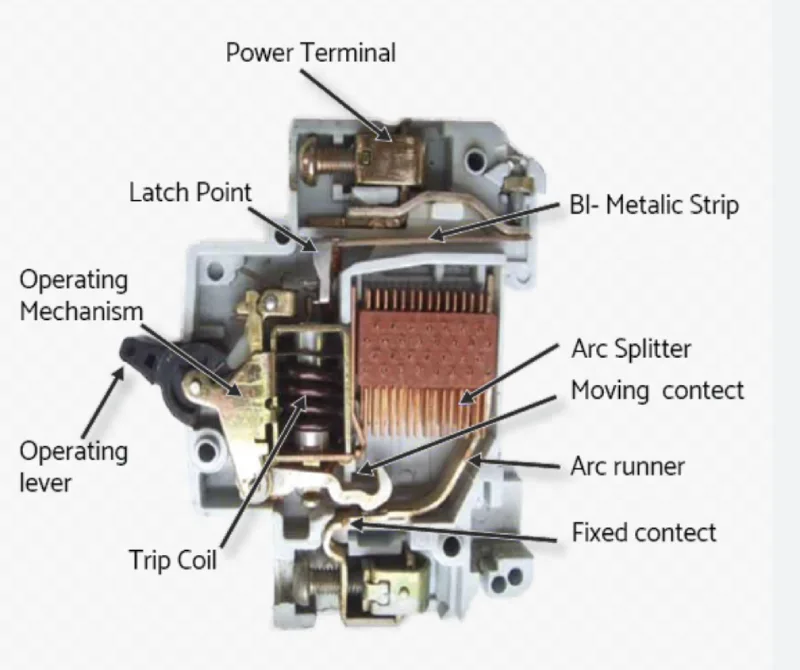ក ធ្នូនៅក្នុង a សៀគ្វីល្មើស គឺជាការឆក់ចរន្តអគ្គិសនីជាបន្តបន្ទាប់ ដែលបង្កើតជាគម្លាតរវាងទំនាក់ទំនងដាច់ដោយឡែក នៅពេលដែលឧបករណ៍បំបែកចរន្តអគ្គិសនីរំខាន។ ការហូរចេញពីប្លាស្មាដែលមានសីតុណ្ហភាពខ្ពស់នេះអាចឡើងដល់សីតុណ្ហភាព 20,000°C (36,000°F) និងបង្កហានិភ័យសុវត្ថិភាពយ៉ាងសំខាន់ ប្រសិនបើមិនបានគ្រប់គ្រងឱ្យបានត្រឹមត្រូវតាមរយៈវិធីសាស្ត្រពិសេសនៃការផុតពូជធ្នូដែលបានបង្កើតឡើងនៅក្នុងឧបករណ៍បំបែកសៀគ្វីទំនើប។
ការយល់ដឹងពីរបៀបបង្កើតធ្នូ និងរបៀបដែលឧបករណ៍បំបែកសៀគ្វីគ្រប់គ្រងពួកវាគឺចាំបាច់សម្រាប់សុវត្ថិភាពអគ្គិសនី ការជ្រើសរើសឧបករណ៍ត្រឹមត្រូវ និងការថែរក្សាប្រព័ន្ធចែកចាយថាមពលដែលអាចទុកចិត្តបានទាំងនៅក្នុងកម្មវិធីលំនៅដ្ឋាន និងឧស្សាហកម្ម។
តើអ្វីទៅជាធ្នូអគ្គិសនីក្នុងឧបករណ៍បំផ្ទុះសៀគ្វី?
និយមន័យបច្ចេកទេស

ក ធ្នូអគ្គិសនី គឺជាការឆក់អគ្គិសនីភ្លឺរវាងអេឡិចត្រូត (ទំនាក់ទំនងឧបករណ៍បំបែកសៀគ្វី) តាមរយៈឧបករណ៍ផ្ទុកឧស្ម័នអ៊ីយ៉ូដ។ នៅពេលដែលឧបករណ៍បំលែងសៀគ្វីបើកនៅក្រោមបន្ទុក ការបំបែកទំនាក់ទំនងបង្កើតគម្លាតដែលចរន្តអគ្គិសនីបន្តហូរតាមរយៈភាគល្អិតខ្យល់អ៊ីយ៉ូដ បង្កើតជាឆានែលប្លាស្មាដែលទ្រទ្រង់ការភ្ជាប់ចរន្តអគ្គិសនីជាបណ្តោះអាសន្ន។
ដំណើរការបង្កើតធ្នូ
នេះគឺជាតារាងដែលបង្ហាញពីដំណើរការបង្កើតធ្នូជាជំហានៗនៅក្នុងឧបករណ៍បំបែកសៀគ្វី៖
| ដំណាក់កាល | ដំណើរការ | រយៈពេល | សីតុណ្ហភាព | លក្ខណៈសំខាន់ៗ |
|---|---|---|---|---|
| 1. ការបំបែកទំនាក់ទំនង | ការបើកមេកានិចចាប់ផ្តើម | 0-5ms | ធម្មតា។ | គម្លាតរាងកាយចាប់ផ្តើមបង្កើត |
| 2. អ៊ីយ៉ូដដំបូង | ម៉ូលេគុលខ្យល់អ៊ីយ៉ូដ | 5-10ms | 3,000°C | ការបង្កើតប្លាស្មាដំបូង |
| 3. ការបង្កើតធ្នូ | ទម្រង់ឆានែលប្លាស្មាមានស្ថេរភាព | 10-20ms | 10,000-20,000°C | លំហូរចរន្តបន្ត |
| 4. ការផុតពូជធ្នូ | ប្រព័ន្ធបំបែកធ្វើឱ្យសកម្ម | 20-100ms | ថយចុះ | ការបង្ក្រាបធ្នូចាប់ផ្តើម |
| 5. ការរំខានចុងក្រោយ | បច្ចុប្បន្នបានបញ្ឈប់ទាំងស្រុង | 100ms+ | ធម្មតា។ | សម្រេចបានភាពឯកោដោយសុវត្ថិភាព |
លក្ខណៈសម្បត្តិរូបវន្តនៃសៀគ្វីបំបែកសៀគ្វី
លក្ខណៈធ្នូ៖
- សីតុណ្ហភាព: 10,000-20,000°C (ប្រៀបធៀបនឹងផ្ទៃព្រះអាទិត្យ)
- វ៉ុល: ជាធម្មតា 20-100 វ៉ុលឆ្លងកាត់ធ្នូ
- ដង់ស៊ីតេបច្ចុប្បន្ន៖ រហូតដល់ 1,000 អំពែរក្នុងមួយសង់ទីម៉ែត្រការ៉េ
- អ៊ីយ៉ូដ៖ ការបំបែកពេញលេញនៃម៉ូលេគុលខ្យល់ទៅជាប្លាស្មា
- ការបំភាយពន្លឺ៖ ពន្លឺពណ៌ស-ខៀវខ្លាំងពីការបញ្ចេញប្លាស្មា
ហេតុអ្វីបានជា Circuit Breaker Arcs Form និងគ្រោះថ្នាក់របស់ពួកគេ។
មូលហេតុឫសគល់នៃការបង្កើតធ្នូ
ធ្នូបង្កើតបានជាឧបករណ៍បំបែកសៀគ្វី ដោយសារគោលការណ៍រូបវិទ្យាអគ្គិសនីជាមូលដ្ឋាន៖
- ការបន្តបច្ចុប្បន្ន៖ ចរន្តអគ្គិសនីព្យាយាមរក្សាផ្លូវរបស់វា ទោះបីជាទំនាក់ទំនងដាច់ដោយឡែកក៏ដោយ។
- អ៊ីយ៉ូដខ្យល់៖ តង់ស្យុងខ្ពស់ឆ្លងកាត់ចន្លោះតូចៗ ionizes ម៉ូលេគុលខ្យល់
- និរន្តរភាពប្លាស្មា៖ នៅពេលដែលបង្កើតឡើង ធ្នូអាចទ្រទ្រង់ដោយខ្លួនឯងតាមរយៈអ៊ីយ៉ូដកម្ដៅ
- ឥទ្ធិពលម៉ាញេទិក៖ ធ្នូដែលផ្ទុកបច្ចុប្បន្នបង្កើតវាលម៉ាញេទិកដែលអាចប៉ះពាល់ដល់ឥរិយាបថរបស់ធ្នូ
គ្រោះថ្នាក់ និងហានិភ័យសុវត្ថិភាព
⚠️ ការព្រមានអំពីសុវត្ថិភាព៖ ធ្នូដែលមិនអាចគ្រប់គ្រងបាននៅក្នុងឧបករណ៍បំពងសៀគ្វីបង្កគ្រោះថ្នាក់ធ្ងន់ធ្ងររួមមានៈ
- ហានិភ័យភ្លើង៖ សីតុណ្ហភាពធ្នូអាចបញ្ឆេះវត្ថុដែលងាយឆេះនៅក្បែរនោះ។
- គ្រោះថ្នាក់នៃការផ្ទុះ៖ ការពង្រីកឧស្ម័នយ៉ាងឆាប់រហ័ស និងការកើនឡើងសម្ពាធនៅក្នុងកន្លែងបិទជិត
- ការបញ្ចេញឧស្ម័នពុល៖ ការរលួយនៃវត្ថុធាតុដើមបង្កើតជាឧស្ម័នដែលបង្កគ្រោះថ្នាក់
- ការខូចខាតឧបករណ៍៖ សំណឹកទំនាក់ទំនងធ្ងន់ធ្ងរ និងការបំបែកអ៊ីសូឡង់
- របួសផ្ទាល់ខ្លួន៖ រលាក ខូចភ្នែក និងគ្រោះថ្នាក់ផ្លូវដង្ហើមដោយសារការប៉ះនឹងធ្នូ
ការគណនាថាមពលធ្នូ
ថាមពលដែលបញ្ចេញដោយធ្នូអាស្រ័យលើវ៉ុល ចរន្ត និងរយៈពេល៖
រូបមន្តថាមពល Arc: E = V × I × t
- អ៊ី = ថាមពល (ជូល)
- V = វ៉ុលធ្នូ (វ៉ុល)
- ខ្ញុំ = បច្ចុប្បន្ន (អំពែរ)
- t = រយៈពេលធ្នូ (វិនាទី)
របៀបបំបែកសៀគ្វីផ្សេងគ្នាដោះស្រាយការផុតពូជរបស់ធ្នូ
ការប្រៀបធៀបវិធីសាស្រ្តនៃការផុតពូជធ្នូ
នេះគឺជាតារាងដ៏ទូលំទូលាយមួយដែលប្រៀបធៀបបច្ចេកវិទ្យានៃការផុតពូជរបស់ឧបករណ៍បំបែកសៀគ្វីផ្សេងៗគ្នា៖
| វិធីសាស្រ្ត | មធ្យម | ជួរវ៉ុល | គុណសម្បត្តិ | គុណវិបត្តិ | កម្មវិធី |
|---|---|---|---|---|---|
| ការសម្រាកខ្យល់ | ខ្យល់បរិយាកាស | ទាប (ក្រោម 1kV) | សាមញ្ញ សន្សំសំចៃ | សមត្ថភាពមានកំណត់ | បន្ទះលំនៅដ្ឋាន |
| ពោរពេញដោយប្រេង | ប្រេងអ៊ីសូឡង់ | មធ្យម (1-38kV) | ត្រជាក់ល្អ បង្ហាញឱ្យឃើញ | ហានិភ័យអគ្គីភ័យ ការថែទាំ | ការដំឡើងចាស់ៗ |
| ឧស្ម័ន SF6 | ស្ពាន់ធ័រ hexafluoride | ខ្ពស់ (38kV+) | ការផុតពូជដ៏អស្ចារ្យ | កង្វល់បរិស្ថាន | ស្ថានីយរង |
| បូមធូលី | កន្លែងទំនេរខ្ពស់។ | មធ្យម (1-38kV) | ស្អាត អាចទុកចិត្តបាន។ | ការផ្សាភ្ជាប់ស្មុគស្មាញ | ប្រព័ន្ធឧស្សាហកម្ម |
| ការផ្ទុះតាមអាកាស | ខ្យល់ដែលបានបង្ហាប់ | ខ្ពស់ (រហូតដល់ 800kV) | ការផុតពូជឆាប់រហ័ស | តម្រូវការសម្ពាធខ្ពស់។ | ស្ថានីយ៍ថាមពល |
បច្ចេកវិទ្យាគ្រប់គ្រងធ្នូកម្រិតខ្ពស់
លក្ខណៈពិសេសនៃឧបករណ៍បំលែងសៀគ្វីទំនើប៖
- Arc Chutes៖ បន្ទះដែកដែលធ្វើអោយត្រជាក់ និង deionize arc plasma
- ការផ្ទុះម៉ាញេទិក៖ វាលម៉ាញេទិកដែលលាតសន្ធឹង និងពន្លត់ធ្នូ
- ការវិវត្តន៍ឧស្ម័ន៖ វត្ថុធាតុដែលបញ្ចេញឧស្ម័នទប់ទល់
- បន្ទប់បូមធូលី៖ លុបបំបាត់ឧបករណ៍ផ្ទុក ionizable ទាំងស្រុង
- ការគ្រប់គ្រងអេឡិចត្រូនិច៖ ពេលវេលាច្បាស់លាស់សម្រាប់ការផុតពូជធ្នូដ៏ល្អប្រសើរ
ការវាយតម្លៃ និងការចាត់ថ្នាក់របស់ឧបករណ៍បំបែកសៀគ្វី
ការវាយតម្លៃបច្ចុប្បន្ននៃកំហុសធ្នូស្តង់ដារ
ការយល់ដឹងអំពីចំណាត់ថ្នាក់ធ្នូរបស់ឧបករណ៍បំបែកសៀគ្វីគឺចាំបាច់សម្រាប់ការជ្រើសរើសត្រឹមត្រូវ៖
| ប្រភេទឧបករណ៍បំបែក | ការវាយតម្លៃធ្នូ (kA) | កម្មវិធីធម្មតា។ | គ។ជ។តម្រូវ |
|---|---|---|---|
| លំនៅដ្ឋាន | 10-22 kA | បន្ទះផ្ទះ | មាត្រា 240.83 |
| ពាណិជ្ជកម្ម | 25-65 kA | អគារការិយាល័យ | មាត្រា 240.86 |
| ឧស្សាហកម្ម | 50-200 kA | ការផលិត | មាត្រា 240.87 |
| ឧបករណ៍ប្រើប្រាស់ | 40-80 kA | ការចែកចាយថាមពល | ស្តង់ដារ IEEE C37 |
ប្រភេទថាមពលឧប្បត្តិហេតុ Arc Flash
កម្រិតការពារពន្លឺរបស់ Arc (សម្រាប់ NFPA 70E):
- ប្រភេទ 1: 4 cal/cm² - ការងារអគ្គិសនីស្តង់ដារ
- ប្រភេទ 2: 8 cal/cm² – ប្រតិបត្តិការ Switchgear
- ប្រភេទទី 3: 25 cal/cm² - ឧបករណ៍ថាមពលខ្ពស់។
- ប្រភេទទី 4: 40 cal/cm² – ការដំឡើងអគ្គិសនីសំខាន់ៗ
ការជ្រើសរើសឧបករណ៍បំបែកសៀគ្វីសម្រាប់ដំណើរការធ្នូ
លក្ខណៈវិនិច្ឆ័យជ្រើសរើសគន្លឹះ
នៅពេលជ្រើសរើសឧបករណ៍បំបែកសៀគ្វីដោយផ្អែកលើសមត្ថភាពគ្រប់គ្រងធ្នូ សូមពិចារណាកត្តាទាំងនេះ៖
តម្រូវការបច្ចេកទេស៖
- មាន Fault Current៖ ត្រូវតែលើសពីចរន្តសៀគ្វីខ្លីអតិបរមាដែលរំពឹងទុក
- ថ្នាក់វ៉ុល៖ តម្រូវការវ៉ុលប្រព័ន្ធដែលត្រូវគ្នា
- សមត្ថភាពរំខាន៖ សមត្ថភាពក្នុងការបំបែកចរន្តកំហុសអតិបរមាដោយសុវត្ថិភាព
- ថាមពល Arc Flash៖ ពិចារណាលើតម្រូវការការពារកម្មករ
- លក្ខខណ្ឌបរិស្ថាន៖ សីតុណ្ហភាព សំណើម និងកម្រិតនៃការចម្លងរោគ
ការណែនាំអំពីកម្មវិធីជាក់លាក់
កម្មវិធីលំនៅឋាន៖
- ប្រើឧបករណ៍បំបែកសៀគ្វី AFCI (Arc Fault Circuit Interrupter) សម្រាប់សៀគ្វីបន្ទប់គេង
- ជ្រើសរើសសមត្ថភាពរំខាន 10kA សម្រាប់ផ្ទះធម្មតា។
- ដំឡើងឧបករណ៍ការពារការកើនឡើងពេញផ្ទះ ដើម្បីកាត់បន្ថយហានិភ័យនៃធ្នូ
កម្មវិធីពាណិជ្ជកម្ម/ឧស្សាហកម្ម៖
- ទាមទារការសិក្សា arc flash សម្រាប់ NFPA 70E
- ប្រើសមត្ថភាពរំខានសមស្របដោយផ្អែកលើការវិភាគបច្ចុប្បន្នកំហុស
- អនុវត្តស្លាកព្រមានភ្លើងសញ្ញាធ្នូ និងតម្រូវការ PPE
- ពិចារណាឧបករណ៍ប្តូរធន់នឹងធ្នូសម្រាប់ការការពារកម្មករ
ការថែទាំធ្នូ និងការដោះស្រាយបញ្ហា
សញ្ញានៃការខូចខាតធ្នូនៅក្នុងឧបករណ៍បំបែកសៀគ្វី
សូចនាករត្រួតពិនិត្យមើលឃើញ៖
- ទំនាក់ទំនងសំណឹកឬរណ្តៅ
- ប្រាក់បញ្ញើកាបូននៅលើទំនាក់ទំនង
- សមាសធាតុដែលខូចឬរលាយ
- សម្ភារៈអ៊ីសូឡង់ដែលឆេះ
- កំណាត់ធ្នូខូចទ្រង់ទ្រាយ ឬរនាំង
សូចនាករការអនុវត្ត៖
- ការរំខានជាញឹកញាប់
- ប្រតិបត្តិការយឺត ឬពន្យារពេល
- សំឡេងមិនធម្មតាអំឡុងពេលប្រតិបត្តិការ
- ការឡើងកំដៅក្នុងកំឡុងពេលផ្ទុកធម្មតា។
- បរាជ័យក្នុងការរំខានចរន្តខុស
តម្រូវការថែទាំវិជ្ជាជីវៈ
⚠️ សេចក្តីជូនដំណឹងអំពីសុវត្ថិភាព៖ ការថែរក្សាអង្គជំនុំជម្រះធ្នូរបស់ឧបករណ៍បំផ្ទុះសៀគ្វីទាមទារបុគ្គលិកអគ្គិសនីដែលមានសមត្ថភាព និងនីតិវិធីសុវត្ថិភាពត្រឹមត្រូវ។
កាលវិភាគថែទាំ៖
- ប្រចាំខែ៖ ការត្រួតពិនិត្យមើលឃើញសម្រាប់សញ្ញានៃការខូចខាត arcing
- ប្រចាំឆ្នាំ៖ ការធ្វើតេស្តប្រតិបត្តិការ និងការត្រួតពិនិត្យទំនាក់ទំនង
- ៣-៥ ឆ្នាំ។៖ ការធ្វើតេស្តទូលំទូលាយតាមស្តង់ដារ NETA
- តាមតម្រូវការ៖ ការជំនួសបន្ទាប់ពីការរំខាននៃកំហុសដ៏សំខាន់
ប្រព័ន្ធការពារ និងរកឃើញធ្នូ
បច្ចេកវិទ្យារកឃើញធ្នូទំនើប
ប្រព័ន្ធអគ្គិសនីកម្រិតខ្ពស់ឥឡូវនេះរួមបញ្ចូលការរកឃើញធ្នូដ៏ទំនើប៖
| បច្ចេកវិទ្យា | វិធីសាស្រ្តរាវរក | ពេលវេលាឆ្លើយតប | កម្មវិធី |
|---|---|---|---|
| ឧបករណ៍ចាប់សញ្ញាពន្លឺ | ការរកឃើញពន្លឺធ្នូ | 2-4 មិល្លីវិនាទី | ការការពារឧបករណ៍ប្តូរ |
| ឧបករណ៍ចាប់សញ្ញាសម្ពាធ | សម្ពាធឧស្ម័នកើនឡើង | 5-10 មិល្លីវិនាទី | ឧបករណ៍បិទជិត |
| ការវិភាគបច្ចុប្បន្ន | លំនាំអាម៉ូនិក | 10-20 មិល្លីវិនាទី | ការការពារសៀគ្វីសាខា |
| សរសៃអុបទិក | ការបញ្ជូនពន្លឺ | 1-2 មិល្លីវិនាទី | ប្រព័ន្ធតង់ស្យុងខ្ពស់។ |
យុទ្ធសាស្ត្រកាត់បន្ថយ Arc Flash
ការគ្រប់គ្រងវិស្វកម្ម៖
- ប្រតិបត្តិការពីចម្ងាយ៖ រក្សាបុគ្គលិកឱ្យនៅឆ្ងាយពីឧបករណ៍ដែលមានថាមពល
- ឧបករណ៍ទប់ទល់នឹងធ្នូ៖ ប្រើ switchgear ដែលបានរចនាជាពិសេស
- ដែនកំណត់បច្ចុប្បន្ន៖ កាត់បន្ថយចរន្តដែលមានកំហុស
- ការការពាររហ័ស៖ ប្រើការបញ្ជូនតការពារល្បឿនលឿន
- ការកាត់បន្ថយថាមពល៖ អនុវត្តការកំណត់របៀបថែទាំ
សំណួរដែលគេសួរញឹកញាប់អំពីសៀគ្វីបំបែកធ្នូ
តើអ្វីទៅដែលធ្វើឱ្យសៀគ្វីដាច់ភ្លើងគ្រោះថ្នាក់ដូច្នេះ?
ឧបករណ៍បំផ្ទុះសៀគ្វីមានគ្រោះថ្នាក់ ព្រោះវាឡើងដល់សីតុណ្ហភាព 20,000°C អាចបញ្ឆេះភ្លើង បង្កើតការផ្ទុះ និងបញ្ចេញឧស្ម័នពុល។ កំដៅ និងថាមពលខ្លាំងអាចបណ្តាលឱ្យរលាកធ្ងន់ធ្ងរ ការខូចខាតឧបករណ៍ និងបង្កគ្រោះថ្នាក់ដល់អាយុជីវិតដល់បុគ្គលិកដែលនៅក្បែរនោះ។
តើ arcs មានរយៈពេលប៉ុន្មាននៅក្នុងសៀគ្វី breakers?
ឧបករណ៍បំលែងសៀគ្វីទំនើបពន្លត់ធ្នូក្នុងរយៈពេល 20-100 មិល្លីវិនាទីក្រោមលក្ខខណ្ឌធម្មតា។ ទោះយ៉ាងណាក៏ដោយ ប្រសិនបើសមត្ថភាពរំខានលើស ឬដំណើរការខុសប្រក្រតី ធ្នូអាចបន្តបានយូរ បង្កើនហានិភ័យសុវត្ថិភាព និងការខូចខាតឧបករណ៍។
តើអ្នកអាចឃើញធ្នូបង្កើតឡើងនៅក្នុងឧបករណ៍បំបែកសៀគ្វីទេ?
អ្នកមិនគួរសង្កេតមើលការបង្កើតធ្នូដោយចេតនានោះទេ ព្រោះពន្លឺខ្លាំងអាចបណ្តាលឱ្យខូចភ្នែកជាអចិន្ត្រៃយ៍។ Arcs បង្កើតពន្លឺពណ៌ស-ខៀវដ៏ភ្លឺស្វាង ហើយគួរតែត្រូវបានសង្កេតឃើញតាមរយៈឧបករណ៍ការពារត្រឹមត្រូវដោយបុគ្គលិកអគ្គិសនីដែលមានលក្ខណៈសម្បត្តិគ្រប់គ្រាន់ក្នុងអំឡុងពេលដំណើរការសាកល្បង។
តើអ្វីដែលធ្វើឲ្យសៀគ្វីដាច់ចរន្តអគ្គិសនីធ្ងន់ធ្ងរជាងនេះ?
ភាពធ្ងន់ធ្ងរនៃធ្នូកើនឡើងជាមួយនឹងចរន្តដែលមានកំហុសខ្ពស់ ថិរវេលាធ្នូវែងជាង សមត្ថភាពរំខានមិនគ្រប់គ្រាន់ ទំនាក់ទំនងកខ្វក់ សមាសធាតុពាក់ និងការដំឡើងមិនត្រឹមត្រូវ។ កត្តាបរិស្ថានដូចជាសំណើម និងកម្ពស់ក៏ប៉ះពាល់ដល់លក្ខណៈធ្នូផងដែរ។
តើអ្នកការពារធ្នូគ្រោះថ្នាក់នៅក្នុងឧបករណ៍បែកសៀគ្វីដោយរបៀបណា?
ទប់ស្កាត់ការកកស្ទះដែលមានគ្រោះថ្នាក់ដោយជ្រើសរើសឧបករណ៍បំបែកដែលមានសមត្ថភាពរំខានគ្រប់គ្រាន់ រក្សាការបោសសំអាតត្រឹមត្រូវ រក្សាទំនាក់ទំនងឱ្យស្អាត អនុវត្តតាមកាលវិភាគថែទាំរបស់អ្នកផលិត និងប្រើប្រាស់ឧបករណ៍ការពារពន្លឺភ្លើង។ ការធ្វើតេស្ត និងការត្រួតពិនិត្យជាប្រចាំគឺចាំបាច់ណាស់។
តើអ្វីជាភាពខុសគ្នារវាងកំហុសធ្នូ និងការការពារកំហុសដី?
ការការពារកំហុស Arc រកឃើញលក្ខខណ្ឌគ្រោះថ្នាក់នៅក្នុងខ្សែភ្លើង ខណៈពេលដែលការការពារកំហុសដីរកឃើញការលេចធ្លាយបច្ចុប្បន្នទៅដី។ ទាំងពីរនេះគឺជាលក្ខណៈពិសេសសុវត្ថិភាពដ៏សំខាន់ ប៉ុន្តែការការពារកំហុសធ្នូជាពិសេសដោះស្រាយនូវគ្រោះថ្នាក់ភ្លើងពីខ្សែភ្លើងដែលខូច ឬកាន់តែយ៉ាប់យ៉ឺន។
តើនៅពេលណាដែលអ្នកគួរជំនួសឧបករណ៍បំប្លែងសៀគ្វីបន្ទាប់ពីខូចធ្នូ?
ជំនួសឧបករណ៍បំលែងសៀគ្វីភ្លាមៗបន្ទាប់ពីការខូចខាតធ្នូយ៉ាងសំខាន់ រួមទាំងការសាយភាយទំនាក់ទំនងដែលអាចមើលឃើញ ប្រាក់បញ្ញើកាបូន សមាសធាតុរលាយ ឬបន្ទាប់ពីមានការរំខានដល់ចរន្តដែលមានកំហុសនៅជិតដែនកំណត់វាយតម្លៃរបស់វា។ សញ្ញាណាមួយនៃការខូចខាតធ្នូធានាការវាយតម្លៃប្រកបដោយវិជ្ជាជីវៈ។
តើការដាច់ចរន្តអគ្គិសនីអាចបណ្តាលឲ្យឆេះបានទេ?
បាទ/ចាស៎ ការដាច់ចរន្តអគ្គិសនីដែលមិនអាចគ្រប់គ្រងបានគឺជាមូលហេតុចម្បងនៃការឆាបឆេះអគ្គិសនី។ សីតុណ្ហភាពធ្នូលើសពី 20,000°C អាចបញ្ឆេះសម្ភារៈដែលងាយឆេះនៅក្បែរនោះ។ នេះជាមូលហេតុដែលការរចនាការផុតពូជត្រឹមត្រូវ និងការការពារ AFCI គឺជាតម្រូវការសុវត្ថិភាពដ៏សំខាន់។
ការដំឡើងវិជ្ជាជីវៈ និងការអនុលោមតាមកូដ
តម្រូវការគ.ជ.ប សម្រាប់ការការពារធ្នូ
ស្តង់ដារកូដអគ្គិសនីជាតិ៖
- មាត្រា 210.12៖ តម្រូវការ AFCI សម្រាប់លំនៅដ្ឋាន
- មាត្រា ២៤០៖ តម្រូវការឧបករណ៍ការពារចរន្តលើស
- មាត្រា 110.16៖ លក្ខខណ្ឌតម្រូវការព្រមានភ្លើងសញ្ញាធ្នូ
- មាត្រា 110.24៖ សញ្ញាសម្គាល់បច្ចុប្បន្នមានកំហុស
តម្រូវការវិញ្ញាបនប័ត្រ និងការបណ្តុះបណ្តាល
គុណវុឌ្ឍិវិជ្ជាជីវៈ៖
- ជាងអគ្គិសនីដែលមានអាជ្ញាប័ណ្ណសម្រាប់ដំឡើង និងថែទាំ
- ការបណ្តុះបណ្តាល NFPA 70E សម្រាប់សុវត្ថិភាពពន្លឺភ្លើង
- ការបណ្តុះបណ្តាលជាក់លាក់របស់អ្នកផលិតសម្រាប់ឧបករណ៍ឯកទេស
- ការអប់រំបន្តសម្រាប់ការធ្វើបច្ចុប្បន្នភាពកូដ និងនីតិវិធីសុវត្ថិភាព
ការណែនាំពីអ្នកជំនាញសម្រាប់សុវត្ថិភាពនៃការបំបែកសៀគ្វីធ្នូ
💡 ដំបូន្មានអ្នកជំនាញ៖ តែងតែផ្ទៀងផ្ទាត់សមត្ថភាពរំខានរបស់ឧបករណ៍បំប្លែងសៀគ្វីទល់នឹងចរន្តកំហុសដែលមានជាក់ស្តែង តាមរយៈការវិភាគចរន្តកំហុសវិជ្ជាជីវៈ។ ការដំឡើងឧបករណ៍បំផ្ទុះដែលមានសមត្ថភាពមិនគ្រប់គ្រាន់អាចបណ្តាលឱ្យមានការបរាជ័យដ៏មហន្តរាយក្នុងអំឡុងពេលមានកំហុស។
💡 ដំបូន្មានអ្នកជំនាញ៖ អនុវត្តកម្មវិធីសុវត្ថិភាពភ្លើងសញ្ញាធ្នូដ៏ទូលំទូលាយរួមទាំងការវិភាគគ្រោះថ្នាក់ PPE ត្រឹមត្រូវ ស្លាកសញ្ញាព្រមាន និងការបណ្តុះបណ្តាលកម្មករ។ ឧប្បត្តិហេតុ Arc flash គឺអាចការពារបានជាមួយនឹងនីតិវិធីសុវត្ថិភាព និងឧបករណ៍ត្រឹមត្រូវ។
💡 ដំបូន្មានអ្នកជំនាញ៖ ពិចារណាលើការដំឡើងឧបករណ៍បំលែងសៀគ្វីប្រេងចាស់ទៅជាម៉ាស៊ីនបូមធូលីទំនើប ឬបច្ចេកវិទ្យា SF6 សម្រាប់ការធ្វើឱ្យប្រសើរឡើងនូវការអនុវត្តការផុតពូជរបស់ធ្នូ និងកាត់បន្ថយតម្រូវការថែទាំ។
សេចក្តីសន្និដ្ឋាន៖ ការគ្រប់គ្រងសៀគ្វីសុវត្ថិភាព ធ្នូរបស់ឧបករណ៍បំបែកសៀគ្វី
ការយល់ដឹងអំពីធ្នូនៅក្នុងឧបករណ៍បំបែកសៀគ្វីគឺជាមូលដ្ឋានគ្រឹះនៃសុវត្ថិភាពអគ្គិសនី និងភាពជឿជាក់នៃប្រព័ន្ធ។ ការឆក់ប្លាស្មាដែលមានថាមពលខ្ពស់ទាំងនេះទាមទារវិធីសាស្ត្រផុតពូជដ៏ទំនើបដែលត្រូវបានបង្កើតឡើងនៅក្នុងឧបករណ៍បំបែកសៀគ្វីទំនើបដើម្បីការពារទាំងឧបករណ៍ និងបុគ្គលិក។
គន្លឹះសំខាន់ៗសម្រាប់អ្នកជំនាញអគ្គិសនី៖
- ធ្នូគឺជៀសមិនរួចនៅពេលដែលរំខានចរន្តអគ្គិសនីនៅក្រោមបន្ទុក
- ការជ្រើសរើសឧបករណ៍បំបែកសៀគ្វីត្រឹមត្រូវដោយផ្អែកលើការវិភាគចរន្តកំហុសគឺមានសារៈសំខាន់
- ការថែទាំនិងការត្រួតពិនិត្យជាទៀងទាត់ការពារការបរាជ័យដែលទាក់ទងនឹងធ្នូ
- កម្មវិធីការពារពន្លឺ Arc ជួយសង្រ្គោះជីវិត និងការពារការរងរបួស
- បច្ចេកវិជ្ជារាវរក និងកាត់បន្ថយទំនើប ធ្វើអោយប្រសើរឡើងនូវសុវត្ថិភាពយ៉ាងខ្លាំង
សម្រាប់ប្រព័ន្ធអគ្គិសនីដ៏ស្មុគស្មាញ ឬកម្មវិធីថាមពលខ្ពស់ តែងតែពិគ្រោះជាមួយវិស្វករអគ្គិសនីដែលមានលក្ខណៈសម្បត្តិគ្រប់គ្រាន់ ហើយអនុវត្តតាមកូដ និងស្តង់ដារដែលអាចអនុវត្តបាន។ ការវិនិយោគលើការការពារធ្នូ និងវិធានការសុវត្ថិភាពត្រឹមត្រូវ លើសពីការចំណាយដ៏មហន្តរាយនៃឧបទ្ទវហេតុ arc flash ឬការបរាជ័យឧបករណ៍។
ចងចាំ៖ នៅពេលមានការសង្ស័យអំពីដំណើរការធ្នូរបស់ឧបករណ៍បំផ្ទុះសៀគ្វី ឬតម្រូវការសុវត្ថិភាព សូមចូលរួមជាមួយអ្នកជំនាញអគ្គិសនីដែលមានការបញ្ជាក់ដែលអាចធ្វើការវិភាគបានត្រឹមត្រូវ និងធានាបាននូវការដំឡើងស្របតាមកូដដែលការពារទាំងមនុស្ស និងទ្រព្យសម្បត្តិ។




